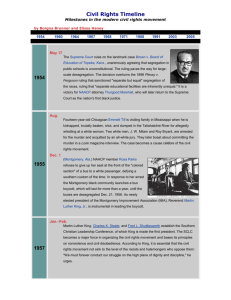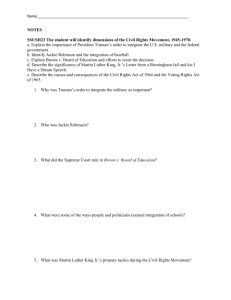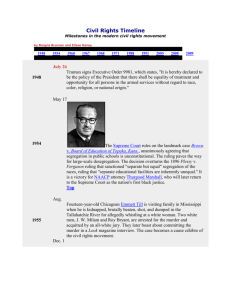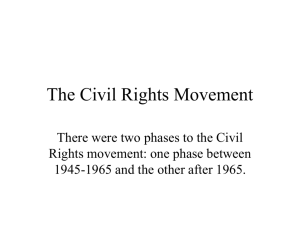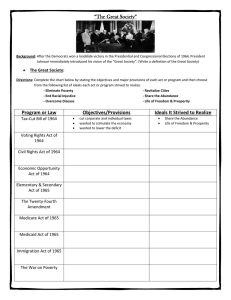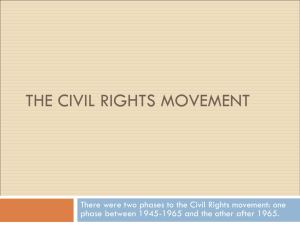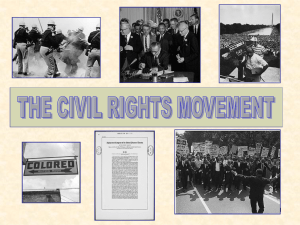Civil Rights Timeline - Somerset Independent Schools
advertisement
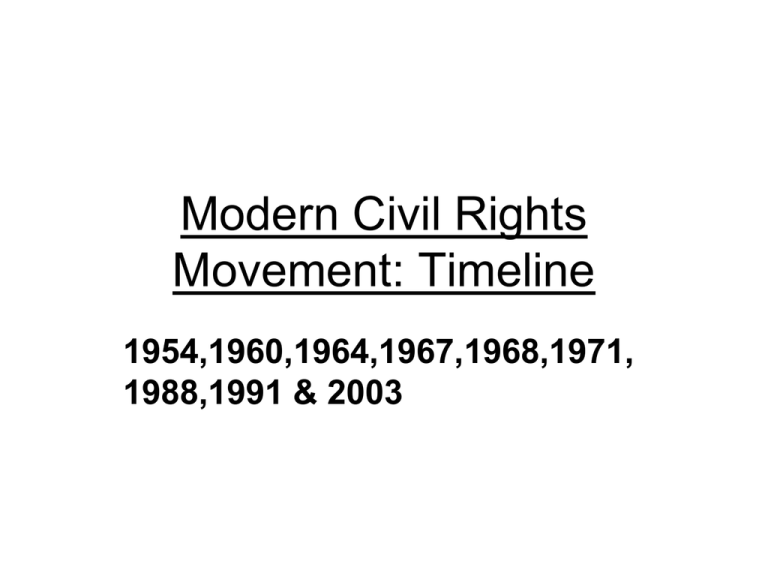
Modern Civil Rights Movement: Timeline 1954,1960,1964,1967,1968,1971, 1988,1991 & 2003 May 17, 1954: • The Supreme Court rules on the landmark case Brown v. Board of Education of Topeka,Kansas • unanimously agreeing that segregation in public schools is unconstitutional. The ruling paves the way for large-scale desegregation. • The decision overturns the 1896 Plessy v. Ferguson ruling that sanctioned "separate but equal" segregation of the races, ruling that "separate educational facilities are inherently unequal.“ • It is a victory for NAACP attorney Thurgood Marshall, who will later return to the Supreme Court as the nation's first black justice. August,1955: • Fourteen-year-old Chicagoan Emmett Till is visiting family in Mississippi when he is kidnapped, brutally beaten, shot, and dumped in the Tallahatchie River for allegedly whistling at a white woman • Two white men, J. W. Milam and Roy Bryant, are arrested for the murder and acquitted by an all-white jury. • They later boast about committing the murder in a Look magazine interview. The case becomes a cause célèbre of the civil rights movement. December 1, 1955: • (Montgomery, Ala.) NAACP member Rosa Parks refuses to give up her seat at the front of the "colored section" of a bus to a white passenger, defying a southern custom of the time • In response to her arrest the Montgomery black community launches a bus boycott, which will last for more than a year, until the buses are desegregated Dec. 21, 1956. • As newly elected president of the Montgomery Improvement Association (MIA), Reverend Martin Luther King, Jr., is instrumental in leading the boycott. January-February, 1957: • Martin Luther King, Charles K. Steele, and Fred L. Shuttlesworth establish the Southern Christian Leadership Conference, of which King is made the first president. • The SCLC becomes a major force in organizing the civil rights movement and bases its principles on nonviolence and civil disobedience. • According to King, it is essential that the civil rights movement not sink to the level of the racists and hatemongers who oppose them: "We must forever conduct our struggle on the high plane of dignity and discipline," he urges. September, 1957: • (Little Rock, Ark.) Formerly all-white Central High School learns that integration is easier said than done • Nine black students are blocked from entering the school on the orders of Governor Orval Faubus • President Eisenhower sends federal troops and the National Guard to intervene on behalf of the students, who become known as the "Little Rock Nine." February 1, 1960: • (Greensboro, N.C.) Four black students from North Carolina Agricultural and Technical College begin a sit-in at a segregated Woolworth's lunch counter. • Although they are refused service, they are allowed to stay at the counter • The event triggers many similar nonviolent protests throughout the South. • Six months later the original four protesters are served lunch at the same Woolworth's counter. • Student sit-ins would be effective throughout the Deep South in integrating parks, swimming pools, theaters, libraries, and other public facilities. April, 1960: • (Raleigh, N.C.) The Student Nonviolent Coordinating Committee (SNCC) is founded at Shaw University, providing young blacks with a place in the civil rights movement • The SNCC later grows into a more radical organization, especially under the leadership of Stokely Carmichael (1966–1967). May 4, 1961: • The Congress of Racial Equality (CORE) begins sending student volunteers on bus trips to test the implementation of new laws prohibiting segregation in interstate travel facilities • One of the first two groups of "freedom riders," as they are called, encounters its first problem two weeks later, when a mob in Alabama sets the riders' bus on fire • The program continues, and by the end of the summer 1,000 volunteers, black and white, have participated. October 1, 1961: • James Meredith becomes the first black student to enroll at the University of Mississippi. • Violence and riots surrounding the incident caused President Kennedy to send 5,000 federal troops. April 16, 1963: • Martin Luther King is arrested and jailed during anti-segregation protests in Birmingham, Ala. • He writes his seminal "Letter From Birmingham City Jail," arguing that individuals have the moral duty to disobey unjust laws. May, 1963: • During civil rights protests in Birmingham, Ala., Commissioner of Public Safety Eugene "Bull" Connor uses fire hoses and police dogs on black demonstrators. • These images of brutality, which are televised and published widely, are instrumental in gaining sympathy for the civil rights movement around the world. June 12, 1963: • (Jackson, Miss.) Mississippi's NAACP field secretary, 37-year-old Medgar Evers, is murdered outside his home. • Byron De La Beckwith is tried twice in 1964, both trials resulting in hung juries. • Thirty years later he is convicted for murdering Evers. August 28, 1963: • (Washington, D.C.) About 200,000 people join the March on Washington. • Congregating at the Lincoln Memorial, participants listen as Martin Luther King delivers his famous "I Have a Dream" speech. September 15, 1963: • (Birmingham, Ala.) Four young girls attending Sunday school are killed when a bomb explodes at the Sixteenth Street Baptist Church, a popular location for civil rights meetings. • Riots erupt in Birmingham, leading to the deaths of two more black youths. January 23, 1964: • The 24th Amendment abolishes the poll tax, which originally had been instituted in 11 southern states after Reconstruction to make it difficult for poor blacks to vote. Summer, 1964: • The Council of Federated Organizations (COFO), a network of civil rights groups that includes CORE and SNCC, launches a massive effort to register black voters during what becomes known as the Freedom Summer. • It also sends delegates to the Democratic National Convention to protest—and attempt to unseat—the official all-white Mississippi contingent. July 2, 1964: • President Johnson signs the Civil Rights Act of 1964. The most sweeping civil rights legislation since Reconstruction, the Civil Rights Act prohibits discrimination of all kinds based on race, color, religion, or national origin. • The law also provides the federal government with the powers to enforce desegregation August 4, 1964: • (Neshoba Country, Miss.) The bodies of three civilrights workers—two white, one black—are found in an earthen dam, six weeks into a federal investigation backed by President Johnson. • James E. Chaney, 21; Andrew Goodman, 21; and Michael Schwerner, 24, had been working to register black voters in Mississippi • On June 21, had gone to investigate the burning of a black church. They were arrested by the police on speeding charges, incarcerated for several hours, and then released after dark into the hands of the Ku Klux Klan, who murdered them. February 21, 1965: • (Harlem, N.Y.) Malcolm X, black nationalist and founder of the Organization of Afro-American Unity, is shot to death. • It is believed the assailants are members of the Black Muslim faith, which Malcolm had recently abandoned in favor of orthodox Islam. March 7, 1965: • (Selma, Ala.) Blacks begin a march to Montgomery in support of voting rights but are stopped at the Emund Pettus Bridge by a police blockade. • Fifty marchers are hospitalized after police use tear gas, whips, and clubs against them. The incident is dubbed "Bloody Sunday" by the media. August 10, 1965: • Congress passes the Voting Rights Act of 1965, making it easier for Southern blacks to register to vote. • Literacy tests and other such requirements that were used to restrict black voting are made illegal. August 11-17, 1965: • (Watts, Calif.) Race riots erupt in a black section of Los Angeles. September 24, 1965: • Asserting that civil rights laws alone are not enough to remedy discrimination. • President Johnson issues Executive Order 11246, which enforces affirmative action for the first time. • It requires government contractors to "take affirmative action" toward prospective minority employees in all aspects of hiring and employment. October, 1966: • (Oakland, Calif.) The militant Black Panthers are founded by Huey Newton and Bobby Seale. April 19, 1967: • Stokely Carmichael, a leader of the Student Nonviolent Coordinating Committee (SNCC), coins the phrase "black power" in a speech in Seattle. • He defines it as an assertion of black pride and "the coming together of black people to fight for their liberation by any means necessary." • The term's radicalism alarms many who believe the civil rights movement's effectiveness and moral authority crucially depend on nonviolent civil disobedience June 12, 1967: • In Loving v. Virginia, the Supreme Court rules that prohibiting interracial marriage is unconstitutional. • Sixteen states that still banned interracial marriage at the time are forced to revise their laws. July, 1967: • Major race riots take place in Newark (July 12–16) and Detroit (July 23–30). April 4, 1968: • (Memphis, Tenn.) Martin Luther King, at age 39, is shot as he stands on the balcony outside his hotel room. • Escaped convict and committed racist James Earl Ray is convicted of the crime. April 11, 1968: • President Johnson signs the Civil Rights Act of 1968, prohibiting discrimination in the sale, rental, and financing of housing. April 20, 1971: • The Supreme Court, in Swann v. CharlotteMecklenburg Board of Education, upholds busing as a legitimate means for achieving integration of public schools. • Although largely unwelcome (and sometimes violently opposed) in local school districts, courtordered busing plans in cities such as Charlotte, Boston, and Denver continue until the late 1990s. March 22, 1988: • Overriding President Reagan's veto, Congress passes the Civil Rights Restoration Act, which expands the reach of non-discrimination laws within private institutions receiving federal funds. November 22, 1991: • After two years of debates, vetoes, and threatened vetoes, President Bush reverses himself and signs the Civil Rights Act of 1991, strengthening existing civil rights laws and providing for damages in cases of intentional employment discrimination. April 29, 1992: • (Los Angeles, Calif.) The first race riots in decades erupt in south-central Los Angeles after a jury acquits four white police officers for the videotaped beating of African American Rodney King. June 23, 2003: • In the most important affirmative action decision since the 1978 Bakke case, the Supreme Court (5–4) upholds the University of Michigan Law School's policy, ruling that race can be one of many factors considered by colleges when selecting their students because it furthers "a compelling interest in obtaining the educational benefits that flow from a diverse student body." Gratz v. Bollinger (Undergraduate college applicant). • Ruling: 6 to 3 • 6 opposed the 20 point system-unconstitutional Grutter v. Bollinger (Law School applicant) • Ruling: 5 to 4 • 5 in favor of the use of “race” • Note: In order to achieve student body diversity, the University of Michigan uses race as one factor in admitting students. Two lawsuits challenge the use of race and ethnicity at the University: Grutter v. Bollinger (Law School applicant) and Gratz v. Bollinger (Undergraduate college applicant). Petitioners (both white female students) felt that their rejections violate the Equal Protection Clause of the 14th Amendment (Title VI of the Civil Rights Act of 1964).

